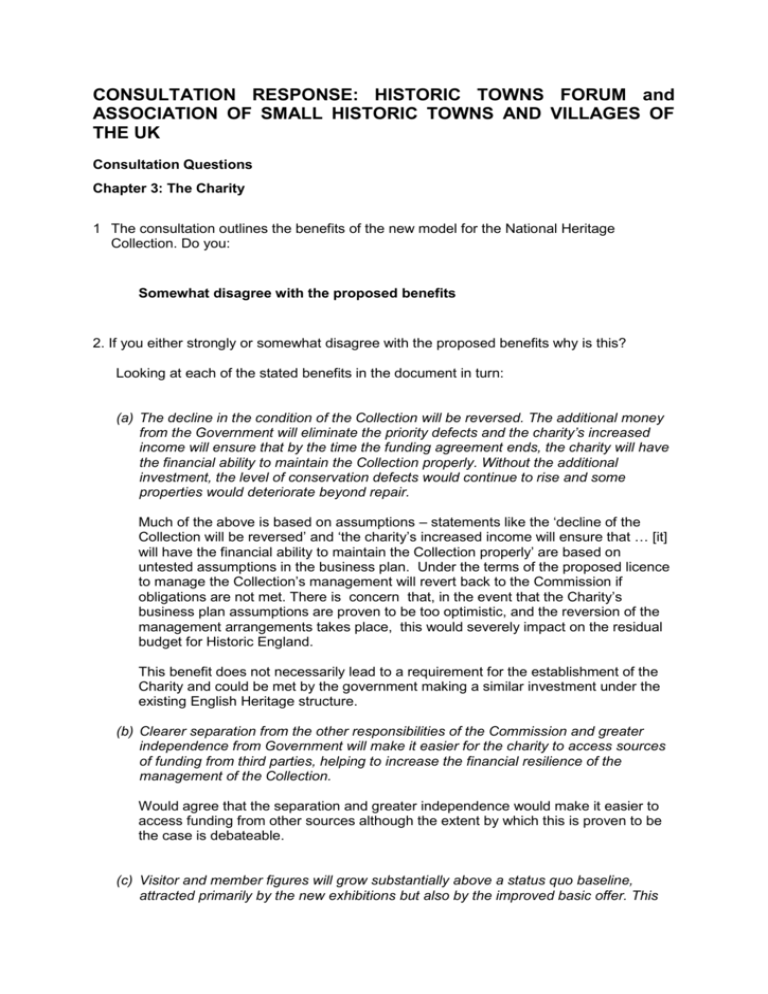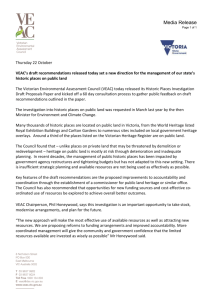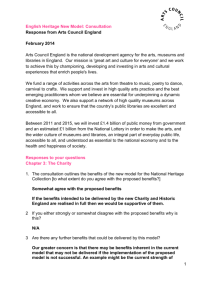response - The Heritage Alliance
advertisement

CONSULTATION RESPONSE: HISTORIC TOWNS FORUM and ASSOCIATION OF SMALL HISTORIC TOWNS AND VILLAGES OF THE UK Consultation Questions Chapter 3: The Charity 1 The consultation outlines the benefits of the new model for the National Heritage Collection. Do you: Somewhat disagree with the proposed benefits 2. If you either strongly or somewhat disagree with the proposed benefits why is this? Looking at each of the stated benefits in the document in turn: (a) The decline in the condition of the Collection will be reversed. The additional money from the Government will eliminate the priority defects and the charity’s increased income will ensure that by the time the funding agreement ends, the charity will have the financial ability to maintain the Collection properly. Without the additional investment, the level of conservation defects would continue to rise and some properties would deteriorate beyond repair. Much of the above is based on assumptions – statements like the ‘decline of the Collection will be reversed’ and ‘the charity’s increased income will ensure that … [it] will have the financial ability to maintain the Collection properly’ are based on untested assumptions in the business plan. Under the terms of the proposed licence to manage the Collection’s management will revert back to the Commission if obligations are not met. There is concern that, in the event that the Charity’s business plan assumptions are proven to be too optimistic, and the reversion of the management arrangements takes place, this would severely impact on the residual budget for Historic England. This benefit does not necessarily lead to a requirement for the establishment of the Charity and could be met by the government making a similar investment under the existing English Heritage structure. (b) Clearer separation from the other responsibilities of the Commission and greater independence from Government will make it easier for the charity to access sources of funding from third parties, helping to increase the financial resilience of the management of the Collection. Would agree that the separation and greater independence would make it easier to access funding from other sources although the extent by which this is proven to be the case is debateable. (c) Visitor and member figures will grow substantially above a status quo baseline, attracted primarily by the new exhibitions but also by the improved basic offer. This means that more people – including more young people – will be able to engage with the history of England. As with (a) above, this is based on, as yet, untested assumptions so that what is meant by ‘substantially’ and whether this will be sufficient to deliver the expected benefits remains to be seen. The reference to more young people becoming engaged with the process seems to be unsubstantiated. There is a risk that the need to achieve financial independence will lead to income generating facilities and entertainment events which will spoil the integrity and character of the place which is intended to be protected.. (d) Greater autonomy from Government means the charity will be able to plan more effectively for the longer term as it will not be as constrained by Government spending controls and cycles as English Heritage is at present. It will be able to carry forward surplus at year end. Greater freedom will enable the charity to enjoy a more flexible and strategic approach to managing the properties and generating income. Agree (e) The charity will not be constrained by Government restrictions on marketing and promotion as English Heritage is now, allowing for more effective business development. Agree (f) The charity will contribute to economic growth by enhancing England’s attractiveness to domestic and foreign tourists. Agree but, with adequate investment, the existing English Heritage model would do also. This benefit is not unique to the new model. 3. Are there any further benefits that could be delivered by this model? In answer to Questions 3 and 4 (below), most of the key benefits and opportunities for earned income are as set out in the consultation paper. However, in terms of the quantum corresponding to these opportunities, there are a number of examples where existing trends are assumed to continue, e.g. in relation to increasing membership and visitors. Little account appears to have been taken of diminishing returns and the possibility that there may not be a direct link between improved assets directly leading to greater numbers of members and visitors. This leads to the question as to what happens when market saturation is reached, possibly well before the anticipated levels? Would this lead to the revocation of the licence and a return to direct management of the National Collection by the Commission with the consequence of placing Historic England’s budgets at risk? 4. Are there any other key opportunities for the charity to increase earned income in addition to those outlined in the consultation? (please tick the appropriate box) Don’t know 5. If yes what are they? 6. What aspects of the current service provided to the public by English Heritage in relation to the National Heritage Collection is it important that the charity maintains? It is vital that the new charity should focus on the conservation of the National Collection for the current and future generations. However, the charity should also act as the showcase for the principles of good practice espoused by its sister organisation, Historic England. In other words, the National Collection should act as exemplars for other owners of historic buildings to follow. In addition to this, the Charity should ensure full access to the National Collection and well informed interpretation and advancing of the public’s knowledge about its heritage assets. There is a concern that investment will be focused on those places which attract high numbers of visitors and have most potential for income generation. It is important that more remote and less visited sites are also properly cared for and conserved, even if they do not generate much income.. 7. What are the opportunities to further enhance the services that will be offered by the charity? The services that will be offered by the charity will, undoubtedly, be enhanced by the capital investment. However, clarity is needed about the arrangements following the expiry of the initial 8-year licence. Although reference is made to this, there is a lack of clarity – merely saying that arrangements will be put into place. There is no doubt that short term licencing hinders long term investment. 8. Do you agree that the suggested charitable objectives are broadly the right ones? Yes but see below The charitable objectives do not seem to be stated in the consultation document but presumably they will be based on the charitable purposes. Whereas these are broadly the right charitable objectives, it may be very difficult to overcome the perception that the charity remains a government agency, particularly given the continuation of the name, which will possibly inhibit philanthropic giving. Although this could be viewed as merely a marketing issue, it could be catastrophic in terms of the ability of the new charity to deliver its objectives. The general public will continue to interface with the new charity in the way that they generally do with the Properties in Care arm of the present English Heritage. The new Historic England will continue to have an interface with a more professional clientele as does the Conservation and Planning arm of the present English Heritage. The general public are unlikely to be aware of the breadth of the present English Heritage functions and so may not appreciate the significance of the new model. Also, clarity needs to be added about the independence of the charity in relation to additions to the National Collection. To what extent would trustees have to exercise fiduciary discretion to refuse new properties and would they be able to acquire properties from third parties on their own discretion. Again, any perception that the Charity is an agent of the Commission which, in turn, is a government agency may have an adverse impact on its fund raising ability. The priority given to public enjoyment of the collection is understandable but there is a danger that the integrity and special character of sites can be spoilt or compromised by inappropriate provision of facilities for visitors. 9. If no, what changes to them do you think should be made? See above 10. Are the proposed success criteria to measure the performance of the charity and to ensure that the benefits are realised the right ones? (please tick the relevant box) Yes but see 11 below 11. If not what else should be included in the success criteria? The emphasis on financial independence is understandable and reasonable but the primary criterion should be protection and conservation of the collection. As referred to above the imperative to achieve financial independence by 2022/23 may lead to development and commercial events which raise short term income but spoil the character and special nature of the sites, which are the very things which should be protected and are likely to be appreciated and valued even more in the future. We have seen growing interest in history and heritage in recent years. England has a unique collection of heritage assets which are likely to have high financial value in the future only if there special nature is protected. Clarity needs to be added as to what happens if these success criteria were not met. Chapter 4: Historic England 12 We are interested in the views of respondents to the proposed future opportunities and priorities for Historic England. Are these the right priorities and opportunities? Is there anything missing? Looking at these in turn: (a) A broad vision The separation of functions is welcome, as is the move towards more cooperative working with owners and developers. Effective partnership working can benefit all parties. However, Historic England must still be an effective guardian, ensuring that places of special importance for historical, architectural, archaeological or landscape reasons are appropriately protected. The wider benefits of heritage management in relation to our quality of life and heritage led regeneration’s contribution to sustainable development of our towns and the economic growth of the country is recognised in the introduction to the consultation paper’s chapter on Historic England. It is, perhaps, to be regretted that the opportunity has not been taken to re-assign the new Historic England to both the Department of Culture Media and Sport and the Communities and Local Government department. This would have cemented the heritage sector into mainstream planning and regeneration, in line with other current initiatives such as the amalgamation of the former Conservation Area Consent regime into the main planning permission process. This would have recognised the wider value of heritage beyond its cultural value. Historic England will need to have the funding and appropriately qualified and experienced staff, able to work cooperatively with other parties, especially in the wake of such substantial reductions in local authority conservation staffing. (b) Constructive conservation The embodiment of the principle of constructive conservation into the development and heritage management process has already proved to be successful and its restatement in the consultation is welcomed. Clearly the balance between ‘sensitive and ‘commercial’ development needs careful consideration but, by and large, the present wording of the National Planning Policy Framework is considered to have given local authorities and the present English Heritage sufficient capacity to achieve this. (c) Better services This is welcomed although it is noted that the proposed Historic England’s services are to be ‘largely’ funded from taxation. In the present circumstances of depleted local authority resources, it is essential that the services remain free of charge if they are to be fully used and, hence, heritage assets protected. An introduction of a charge would suggest that the input of Historic England becomes an added extra rather than something which is integral to the development and heritage management process. It also ensures a unity of standard across all local authorities. (d) Saving heritage at risk This is welcomed although the note made under Qu 8 above is pertinent in relation to the independence of the new charity and the obligation of the trustees to accept additions to the National Collection. (e) Looking to the long term The importance of partnership working in its widest sense is welcomed and is already recognised throughout the full range of services at local government level. Clarity about the reference to ‘reviewing’ the landscape for heritage services is needed. 13. Are the proposed success criteria to measure the performance of Historic England the right ones? (please tick the appropriate box) Yes but see below The success criteria follow on from the proposed benefits set out in the consultation paper about which the following points are made: The benefit arising from a clearer focus emerging from the new model is accepted. The stated benefits relating to owners and developers getting a more responsive service and the heritage at risk continuing to be bought back into economic use do not necessarily follow from the new model but should be an aspiration of the existing organisation. The benefit relating to a more visible and accessible resource for the general public may be a benefit but this remains to be tested. The final benefit regarding the charity no longer having a call on the resources of the commission assumes that there would not be a proportionate decrease in the Commission’s budget to reflect the new charitable arm being self-financing. It also avoids addressing a situation whereby the new charity’s licence is not renewed or is revoked due to poor performance in which case the accountability of both new organisations would become linked again through the Commission’s budget. 14. If not what else should be included in the success criteria? 15. Should the National Heritage Protection Plan form the basis of the business plan for Historic England? (please tick the appropriate box) No 16. If no – why not? Whereas the NHPP should form a principal part of the business plan for Historic England, it should not be exclusively based around it. Positive heritage management and heritage led regeneration can offer so much to the quality of people’s life and the potential for local and national economic growth. The present English Heritage Corporate Plan 2011-2015 recognises this through its 4 strands – Achieving excellence by understanding, by valuing, by caring, through enjoying heritage. Even if the focus on properties in care is extracted, it leaves key roles for Historic England that go beyond the protection emphasis that is set out in the NHPP. The danger is that the new organisation is seen purely as an agency that stands in the way of change (as the working title of the National Heritage Protection Service for Historic England suggested). Heritage management can offer a range of positive benefits that need to be celebrated at both national and local level. 17. Are there any further points you would like to add in relation to the consultation? No About you section 18. Are you responding as an individual or on behalf of an organisation? Part of an organisation. 19. If you are responding on behalf of an organisation what best describes the type of organisation? Organisation representing visitor attractions/tourism Organisation representing owners of historic assets Organisation which represents volunteers/communities The Historic Towns Forum and the Association of Small Historic Towns and Villages represent over 300 members including local authorities, civic societies, town and parish councils, individuals and other organisations. 20. If you are responding as an individual are you an existing English Heritage member and/or volunteer? Yes 21. Are you an owner of a listed building? No 30 Department for Culture, Media and Sport Name Dr Noe:l James Job title Director Organisation Historic Towns Forum/ASHTAV Telephone number 07947 521567 Email address htf@kellogg.ox.ac.uk Postal address HTF, Kellogg College, 60-62 Banbury Road, Oxford, OX26PN Please tick this box if you DO NOT want your responses to be made publicly available. I would like to be kept in contact on the English Heritage new model programme. Communication will be through either DCMS or English Heritage. Your data will not be used for any further purposes. (please tick the appropriate box) Yes No







